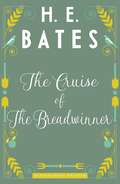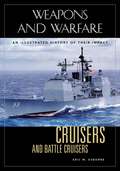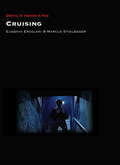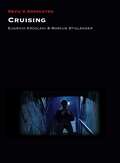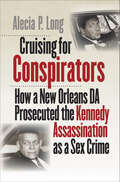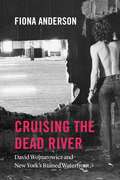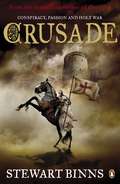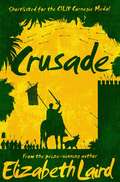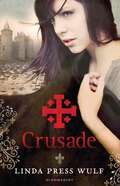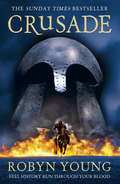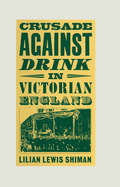- Table View
- List View
The Cruise of The Breadwinner
by H. E. BatesThe Cruise of the Breadwinner is an adventure at sea, following Snowy as he comes of age through a shower of sea-spray and bullets. The youngest crew member on a coastal patrol boat, he longs for action as his sharp eyes pick out distant plane battles and his ears strain to the sound of faint gun-fire. But when finally the war envelops him and his crew-mates in its terrible grasp, he must face the realities of pain, fear, and death. Rescuing two downed pilots, one English and one German, the humanity of the enemy and the true cost of war become all too clear. Here Bates exhibits his staggering ability to write character, building an exhilarating tension on board with the dynamic between the grumbling yet skilful engine operator, the wide eyed enthusiasm of Snowy, and the rotund, clumsily tender Captain. We witness the impact of war's heroics and futility on the boat and the boy during a short, violent voyage off the coast of England, told with such fluency and lightness of touch that it is a tale of action as well as beauty. The New York Times said that Bates "painted it all with a loose, sure brush that does not waste a stroke.†?
The Cruise of the Snark (Dover Maritime Series)
by Jack LondonBarely 30 years old and the wildly popular author of The Call of the Wild, Martin Eden, and other successful novels, Jack London's determined to follow the example of his boyhood idol, Herman Melville, and explore the islands of the South Pacific. Accompanied by his wife and two crew members, London set sail from San Francisco in 1906 aboard the Snark, a custom-made 55-foot ketch.With wry good humor, London recounts both the exhilaration and hardship of a two-year voyage aboard a small, leaky craft. His vital, colorful narrative carries readers along with the intrepid crew through stormy seas, illness, and navigational uncertainty. These difficulties are counterbalanced by abundant rewards, including panoramic vistas of the natural beauties of Hawaii, Bora Bora, Tahiti, the Marquesas Islands, and other exotic locales. The hospitality of the South Pacific islanders proves even more overwhelming than the scenery; everywhere the Snark ventures, its crew is greeted with feasts, celebrations, and lavish expressions of goodwill.Enhanced with 119 original photographs, this rollicking blend of excitement and adventure represents one of the most interesting and best-written narratives of a sea voyage ever written. Related in the compelling voice of a master storyteller, The Cruise of the Snark promises a memorable reading experience for armchair sailors, old salts, and any lover of nautical adventure.
Cruisers and Battle Cruisers: An Illustrated History of Their Impact (Weapons and Warfare)
by Eric W. OsborneFast cruisers, the eyes of the fleet, were the standard-bearers of empire, the ultimate warships of gunboat diplomacy—no other vessel class was so well equipped to serve as both a working war machine and a projection of national might.Cruisers and Battle Cruisers explores the pivotal importance of cruiser-class ships to naval warfare and, in a wider scope, world politics. In vivid but accessible detail, it describes the milestones of cruiser design and deployment from mid-19th century development of steam-propelled, ironclads to the World War I introduction of battle cruisers; from the decisive naval engagements of World War II and the addition of missiles and computerized systems to the most recent developments.Readers will see how specific technological changes progressively increased the destructive power of cruisers and altered their combat roles, how design innovations altered the quality of life aboard ship, and how cruisers came to be called upon to serve a variety of noncombat roles in war and peace.
Cruising (Devil's Advocates)
by Eugenio Ercolani Marcus StigleggerIn the fading atmosphere of the New Hollywood era, William Friedkin – the wunderkind director with an Academy Award for his cop drama, The French Connection (1971) who then scored an even bigger success with The Exorcist (1973) – began work on what would prove to be the most controversial film of his career: Cruising (1980). In the process he established a template for a sub-genre, the serial killer thriller, that would thrive long after his film had left theatres, having caused widespread offence among the very audience he'd hoped to appeal to, via a campaign mobilised by the counter-culture press. As such, Cruising can be read as a bitter farewell to the seventies and its cinema and industry. This Devil's Advocate dives deep into the phenomenon that is Cruising, examining its creative context and its protagonists, as well as examining its ongoing popularity as it turns 40 in 2020.
Cruising (Devil's Advocates)
by Eugenio Ercolani Marcus StigleggerIn the fading atmosphere of the New Hollywood era, William Friedkin – the wunderkind director with an Academy Award for his cop drama, The French Connection (1971) who then scored an even bigger success with The Exorcist (1973) – began work on what would prove to be the most controversial film of his career: Cruising (1980). In the process he established a template for a sub-genre, the serial killer thriller, that would thrive long after his film had left theatres, having caused widespread offence among the very audience he'd hoped to appeal to, via a campaign mobilised by the counter-culture press. As such, Cruising can be read as a bitter farewell to the seventies and its cinema and industry. This Devil's Advocate dives deep into the phenomenon that is Cruising, examining its creative context and its protagonists, as well as examining its ongoing popularity as it turns 40 in 2020.
Cruising for Conspirators: How a New Orleans DA Prosecuted the Kennedy Assassination as a Sex Crime (Boundless South)
by Alecia P. LongNew Orleans district attorney Jim Garrison's decision to arrest Clay Shaw on March 1, 1967, set off a chain of events that culminated in the only prosecution undertaken in the assassination of John F. Kennedy. In the decades since Garrison captured headlines with this high-profile legal spectacle, historians, conspiracy advocates, and Hollywood directors alike have fixated on how a New Orleans–based assassination conspiracy might have worked. Cruising for Conspirators settles the debate for good, conclusively showing that the Shaw prosecution was not based in fact but was a product of the criminal justice system's long-standing preoccupation with homosexuality. Tapping into the public's willingness to take seriously conspiratorial explanations of the Kennedy assassination, Garrison drew on the copious files the New Orleans police had accumulated as they surveilled, harassed, and arrested increasingly large numbers of gay men in the early 1960s. He blended unfounded accusations with homophobia to produce a salacious story of a New Orleans-based scheme to assassinate JFK that would become a national phenomenon. At once a dramatic courtroom narrative and a deeper meditation on the enduring power of homophobia, Cruising for Conspirators shows how the same dynamics that promoted Garrison's unjust prosecution continue to inform conspiratorial thinking to this day.
Cruising the Dead River: David Wojnarowicz and New York's Ruined Waterfront
by Fiona AndersonIn the 1970s, Manhattan’s west side waterfront was a forgotten zone of abandoned warehouses and piers. Though many saw only blight, the derelict neighborhood was alive with queer people forging new intimacies through cruising. Alongside the piers’ sexual and social worlds, artists produced work attesting to the radical transformations taking place in New York. Artist and writer David Wojnarowicz was right in the heart of it, documenting his experiences in journal entries, poems, photographs, films, and large-scale, site-specific projects. In Cruising the Dead River, Fiona Anderson draws on Wojnarowicz’s work to explore the key role the abandoned landscape played in this explosion of queer culture. Anderson examines how the riverfront’s ruined buildings assumed a powerful erotic role and gave the area a distinct identity. By telling the story of the piers as gentrification swept New York and before the AIDS crisis, Anderson unearths the buried histories of violence, regeneration, and LGBTQ activism that developed in and around the cruising scene.
Cruising the Dead River: David Wojnarowicz and New York's Ruined Waterfront
by Fiona AndersonIn the 1970s, Manhattan’s west side waterfront was a forgotten zone of abandoned warehouses and piers. Though many saw only blight, the derelict neighborhood was alive with queer people forging new intimacies through cruising. Alongside the piers’ sexual and social worlds, artists produced work attesting to the radical transformations taking place in New York. Artist and writer David Wojnarowicz was right in the heart of it, documenting his experiences in journal entries, poems, photographs, films, and large-scale, site-specific projects. In Cruising the Dead River, Fiona Anderson draws on Wojnarowicz’s work to explore the key role the abandoned landscape played in this explosion of queer culture. Anderson examines how the riverfront’s ruined buildings assumed a powerful erotic role and gave the area a distinct identity. By telling the story of the piers as gentrification swept New York and before the AIDS crisis, Anderson unearths the buried histories of violence, regeneration, and LGBTQ activism that developed in and around the cruising scene.
Cruising the Dead River: David Wojnarowicz and New York's Ruined Waterfront
by Fiona AndersonIn the 1970s, Manhattan’s west side waterfront was a forgotten zone of abandoned warehouses and piers. Though many saw only blight, the derelict neighborhood was alive with queer people forging new intimacies through cruising. Alongside the piers’ sexual and social worlds, artists produced work attesting to the radical transformations taking place in New York. Artist and writer David Wojnarowicz was right in the heart of it, documenting his experiences in journal entries, poems, photographs, films, and large-scale, site-specific projects. In Cruising the Dead River, Fiona Anderson draws on Wojnarowicz’s work to explore the key role the abandoned landscape played in this explosion of queer culture. Anderson examines how the riverfront’s ruined buildings assumed a powerful erotic role and gave the area a distinct identity. By telling the story of the piers as gentrification swept New York and before the AIDS crisis, Anderson unearths the buried histories of violence, regeneration, and LGBTQ activism that developed in and around the cruising scene.
Cruising the Dead River: David Wojnarowicz and New York's Ruined Waterfront
by Fiona AndersonIn the 1970s, Manhattan’s west side waterfront was a forgotten zone of abandoned warehouses and piers. Though many saw only blight, the derelict neighborhood was alive with queer people forging new intimacies through cruising. Alongside the piers’ sexual and social worlds, artists produced work attesting to the radical transformations taking place in New York. Artist and writer David Wojnarowicz was right in the heart of it, documenting his experiences in journal entries, poems, photographs, films, and large-scale, site-specific projects. In Cruising the Dead River, Fiona Anderson draws on Wojnarowicz’s work to explore the key role the abandoned landscape played in this explosion of queer culture. Anderson examines how the riverfront’s ruined buildings assumed a powerful erotic role and gave the area a distinct identity. By telling the story of the piers as gentrification swept New York and before the AIDS crisis, Anderson unearths the buried histories of violence, regeneration, and LGBTQ activism that developed in and around the cruising scene.
Cruising the Dead River: David Wojnarowicz and New York's Ruined Waterfront
by Fiona AndersonIn the 1970s, Manhattan’s west side waterfront was a forgotten zone of abandoned warehouses and piers. Though many saw only blight, the derelict neighborhood was alive with queer people forging new intimacies through cruising. Alongside the piers’ sexual and social worlds, artists produced work attesting to the radical transformations taking place in New York. Artist and writer David Wojnarowicz was right in the heart of it, documenting his experiences in journal entries, poems, photographs, films, and large-scale, site-specific projects. In Cruising the Dead River, Fiona Anderson draws on Wojnarowicz’s work to explore the key role the abandoned landscape played in this explosion of queer culture. Anderson examines how the riverfront’s ruined buildings assumed a powerful erotic role and gave the area a distinct identity. By telling the story of the piers as gentrification swept New York and before the AIDS crisis, Anderson unearths the buried histories of violence, regeneration, and LGBTQ activism that developed in and around the cruising scene.
Cruising the Dead River: David Wojnarowicz and New York's Ruined Waterfront
by Fiona AndersonIn the 1970s, Manhattan’s west side waterfront was a forgotten zone of abandoned warehouses and piers. Though many saw only blight, the derelict neighborhood was alive with queer people forging new intimacies through cruising. Alongside the piers’ sexual and social worlds, artists produced work attesting to the radical transformations taking place in New York. Artist and writer David Wojnarowicz was right in the heart of it, documenting his experiences in journal entries, poems, photographs, films, and large-scale, site-specific projects. In Cruising the Dead River, Fiona Anderson draws on Wojnarowicz’s work to explore the key role the abandoned landscape played in this explosion of queer culture. Anderson examines how the riverfront’s ruined buildings assumed a powerful erotic role and gave the area a distinct identity. By telling the story of the piers as gentrification swept New York and before the AIDS crisis, Anderson unearths the buried histories of violence, regeneration, and LGBTQ activism that developed in and around the cruising scene.
The Crumbling of Empire: The Disintegration of World Economy (Routledge Library Editions: Modern World Economy)
by M. J. BonnThis book concerns the end of the age of colonization and the inherent changes in the world economy. It discusses the author’s perception of the disintegration of free trade and ideas on the solution of federation. Starting with an introduction to economic thought and history the author then presents the state of the world at the time of writing in terms of colonies and dependencies and looks at economic nationalism and economic separatism. This discursive text is an important account of the global economic issues of the early twentieth century by one of the most well-known economists of the age who became a foremost expert in international financial affairs.
The Crumbling of Empire: The Disintegration of World Economy (Routledge Library Editions: Modern World Economy)
by M. J. BonnThis book concerns the end of the age of colonization and the inherent changes in the world economy. It discusses the author’s perception of the disintegration of free trade and ideas on the solution of federation. Starting with an introduction to economic thought and history the author then presents the state of the world at the time of writing in terms of colonies and dependencies and looks at economic nationalism and economic separatism. This discursive text is an important account of the global economic issues of the early twentieth century by one of the most well-known economists of the age who became a foremost expert in international financial affairs.
Crunchyroll Essential Anime: Fan Favorites, Memorable Masterpieces, and Cult Classics
by Patrick Macias Samuel SattinAn insightful guide to the under-explored medium of anime, Crunchyroll's Essential Anime features 50 influential and unforgettable anime series and films that have left an undeniable impact on our culture. More than just a list of anime to watch, Essential Anime digs into the distinct stories of the creators and studios behind the making of these must-see anime titles, as well as the personal connections and importance they hold with anime fans around the world. With commentary on anime's history and lasting appeal, recommendation lists, and hundreds of stunning images, Crunchyroll's Essential Anime is an indispensable guide for anime lovers and fans, offering an entertaining and moving narrative about anime's true impact on pop culture.Ranging from classic and modern series and films this official guide will explore iconic and must-see: Feature films: Akira (1988), Princess Mononoke (1997), Millennium Actress (2001), Metropolis (2001), Tekkonkinkreet (2006), Sword of the Stranger (2007), Summer Wars (2009), and Your Name (2016) Series: Astro Boy (1963), Lupin the 3rd (1967), Macross (1982), Ranma 1/2 (1989), Neon Genesis Evangelion (1995), Dragon Ball Z (1989), Sailor Moon (1992), Revolutionary Girl Utena (1997), Pokémon (1997), One Piece (1999), K-On! (2007), Fullmetal Alchemist: Brotherhood (2009), Sword Art Online (2012), Yuri On Ice!!! (2016), My Hero Academia (2018), and Demon Slayer: Kimetsu no Yaiba (2019)And more!
Crusade (The Making of England Quartet #2)
by Stewart Binns1072 - England is firmly under the heel of its new Norman rulers. The few survivors of the English resistance look to Edgar the Atheling, the rightful heir to the English throne, to overthrow William the Conqueror. Years of intrigue and vicious civil war follow: brother against brother, family against family, friend against friend.In the face of chaos and death, Edgar and his allies form a secret brotherhood, pledging to fight for justice and freedom wherever they are denied. But soon they are called to fight for an even greater cause: the plight of the Holy Land. Embarking on the epic First Crusade to recapture Jerusalem, together they will participate in some of the cruellest battles the world has ever known, the savage Siege of Antioch and the brutal Fall of Jerusalem, and together they will fight to the death.
Crusade
by Elizabeth LairdCrusade is a richly detailed historical adventure, from Carnegie shortlisted author, Elizabeth Laird.Two boys. Two faiths. One unholy war . . .When Adam's mother dies unconfessed, he pledges to save her soul with dust from the Holy Land. Employed as a dog-boy for the local knight, Adam grabs the chance to join the Crusade to reclaim Jerusalem. He burns with determination to strike down the infidel enemy . . .Salim, a merchant's son, is leading an uneventful life in the port of Acre - until news arrives that a Crusader attack is imminent. To keep Salim safe, his father buys him an apprenticeship with an esteemed, travelling doctor. But Salim's employment leads him to the heart of Sultan Saladin's camp - and into battle against the barbaric and unholy invaders . . .
Crusade
by Linda Press WulfRobert: Left on the steps of a church as a baby, Robert was often hungry but never stole food like the other orphans in town. Introverted and extraordinarily intelligent, he knew all the Latin prayers and hymns by heart by the time he was five years old.Georgette: Her own mother died in childbirth, leaving Georgette with a father who, seventeen at the time, had neither experience nor aptitude as a nurturing parent, and a brother known in town as Le Fuer - The Spitfire - for his terrible temper.Perhaps to replace something missing from their own lives, both Robert and Georgette are drawn to the news of a crusader, twelve or thirteen, no older than themselves, travelling down through France with thousands of followers - all, unbelievably, children too.Of those thousands, this is the incredible story of two. A story of hardship, loss and love.
Crusade: Brethren Trilogy Book 2 (Brethren Trilogy)
by Robyn YoungRobyn Young is a compelling voice in historical fiction, writing in the tradition of Bernard Cornwell, Conn Iggulden and Manda Scott. This is the epic second novel in the million-selling Brethren trilogy.It is 1274 and in the fortified city of Acre, the last major stronghold of the Crusaders in Palestine, an epic conflict is beginning. Will Campbell is a Templar Knight, trained for war, but as a member of the mysterious group known as the Brethren, he is also a man of peace. After years of bloodshed the Brethren have helped create a truce between the Christians and Muslims. But there are those on both side for whom peace is not an option. As war looms, Will is torn between his oath as a Templar, his secret role in the Brethren and his duty to Elwen, the woman he loves but is forbidden to marry.
Crusade against Drink in Victorian England
by Lilian Lewis ShimanDrink, 'the curse of Britain', was sweeping the land, or so it seemed to many Englishmen in the early decades of the nineteenth century. They held it responsible for crime, poverty and many other ills of the rapidly industrializing towns. A 'moderation' temperance reform organized in 1829 largely under middle class auspices soon gave way to a radical commitment to total abstinence in a great variety of worker self-help groups. When these too failed to change the drinking habits of most Englishmen the temperance movement sought new alliances. In the 1870s and 1880s Gospel Temperance married temperance to revivalist religion. It received the support of both established and non-conformist churches, and millions 'took the pledge'. But many did not; and as religious enthusiasm faded the anti-drink forces shifted their attention to the political arena. After successfully pressuring the Liberal Party to adopt limited prohibition, they mounted a great but unsuccessful campaign in the 1895 election. With this defeat the anti-drink crusade disintegrated, leaving the dedicated teetotallers socially isolated in the safe haven of their drink-free subculture.
The Crusade against Heretics in Bohemia, 1418–1437: Sources and Documents for the Hussite Crusades (Crusade Texts in Translation)
by Thomas A. FudgeThis selection of over 200 texts, nearly all appearing for the first time in English translation, provides a close-up look at the crusades against the Hussite heretics of 15th-century Bohemia, from the perspective of the official Church - or at their struggles for religious freedom, from the Hussites' own point of view. It also throws light on the meaning of the crusading movement and on the nature of warfare in the late Middle Ages. There is no single documentary account of the conflict, but the riveting events can be reconstructed from a wide range of contemporary sources: chronicles, sermons, manifestos, songs, bulls, imperial correspondence, military and diplomatic communiqués, liturgy, military ordinances, trade embargos, epic poems, letters from the field, Jewish documents, speeches, synodal proceedings, and documents from popes, bishops, emperors and city councils. These texts reveal the zeal and energy of the crusaders but also their deep disunity, growing frustration and underlying fears - and likewise the heresy, determination and independence of the Hussites. Five times the cross was preached and the vastly superior forces of the official church and the empire marched into Bohemia to suppress the peasant armies. Five times they were humiliated and put to flight.
The Crusade against Heretics in Bohemia, 1418–1437: Sources and Documents for the Hussite Crusades (Crusade Texts in Translation)
by Thomas A. FudgeThis selection of over 200 texts, nearly all appearing for the first time in English translation, provides a close-up look at the crusades against the Hussite heretics of 15th-century Bohemia, from the perspective of the official Church - or at their struggles for religious freedom, from the Hussites' own point of view. It also throws light on the meaning of the crusading movement and on the nature of warfare in the late Middle Ages. There is no single documentary account of the conflict, but the riveting events can be reconstructed from a wide range of contemporary sources: chronicles, sermons, manifestos, songs, bulls, imperial correspondence, military and diplomatic communiqués, liturgy, military ordinances, trade embargos, epic poems, letters from the field, Jewish documents, speeches, synodal proceedings, and documents from popes, bishops, emperors and city councils. These texts reveal the zeal and energy of the crusaders but also their deep disunity, growing frustration and underlying fears - and likewise the heresy, determination and independence of the Hussites. Five times the cross was preached and the vastly superior forces of the official church and the empire marched into Bohemia to suppress the peasant armies. Five times they were humiliated and put to flight.
Crusade and Conversion on the Baltic Frontier 1150–1500
by Alan V. MurrayThis volume represents a major contribution to the history of the Northern Crusades and the Christianization of the Baltic lands in the Middle Ages, from the beginnings of the Catholic mission to the time of the Reformation. The subjects treated range from discussions of the ideology and practice of crusade and conversion, through studies of the motivation of the crusading countries (Denmark, Sweden and Germany) and the effects of the crusades on the countries of the eastern Baltic coast (Finland, Estonia, Livonia, Prussia and Lithuania), to analyses of the literature and historiography of the crusade. It brings together essays from both established and younger scholars from the western tradition with those from the modern Baltic countries and Russia, and presents in English some of the fruits of the first decade of historical scholarship and dialogue after the collapse of the Iron Curtain. The depth of treatment, diversity of approaches, and accompanying bibliography of publications make this collection a major resource for the teaching of the Baltic Crusades.
Crusade and Conversion on the Baltic Frontier 1150–1500
by Alan V. MurrayThis volume represents a major contribution to the history of the Northern Crusades and the Christianization of the Baltic lands in the Middle Ages, from the beginnings of the Catholic mission to the time of the Reformation. The subjects treated range from discussions of the ideology and practice of crusade and conversion, through studies of the motivation of the crusading countries (Denmark, Sweden and Germany) and the effects of the crusades on the countries of the eastern Baltic coast (Finland, Estonia, Livonia, Prussia and Lithuania), to analyses of the literature and historiography of the crusade. It brings together essays from both established and younger scholars from the western tradition with those from the modern Baltic countries and Russia, and presents in English some of the fruits of the first decade of historical scholarship and dialogue after the collapse of the Iron Curtain. The depth of treatment, diversity of approaches, and accompanying bibliography of publications make this collection a major resource for the teaching of the Baltic Crusades.
Crusade and Jihad: The Thousand-Year War Between the Muslim World and the Global North (The\henry L. Stimson Lectures Ser.)
by William R. PolkCrusade and Jihad is the first book to encompass, in one volume, the entire history of the catastrophic encounter between the Global North—China, Russia, Europe, Britain, and America—and Muslim societies from Central Asia to West Africa. William R. Polk draws on more than half a century of experience as a historian, policy planner, diplomat, peace negotiator, and businessman to explain the deep hostilities between the Muslim world and the Global North and show how they grew over the centuries. Polk shows how Islam arose and spread across North Africa into Europe, climaxed in the vibrant and sophisticated caliphate of al-Andalus in medieval Spain, and was the bright light in a European Dark Age. Simultaneously, Islam spread from the Middle East into Africa, India, and Southeast Asia. But following the Mongol invasions, Islamic civilization entered a decline while Europe began its overseas expansion. Portuguese buccaneers dominated the Indian Ocean; the Dutch and the English established powerful corporations that turned India and Indonesia into colonies; Russian armies pushed down the Volga into Central Asia, destroying its city-states; and the Chinese Qing dynasty slaughtered an entire Central Asian people. Britain crushed local industry and drained off wealth throughout its vast colonies. Defeated at every turn, Muslims tried adopting Western dress, organizing Westernstyle armies, and embracing Western ideas. None of these efforts stopped the conquests. For Europe and Russia, the nineteenth century was an age of colonial expansion, but for the Muslim world it was an age of brutal and humiliating defeat. Millions were driven from their homes, starved, or killed, and their culture and religion came under a century-long assault. In the twentieth century, brutalized and and disorganized native societies, even after winning independence, fell victim to “post-imperial malaise,” typified by native tyrannies, corruption, and massive poverty. The result was a furious blowback. A sobering, scrupulous, and frank account of imperialism, colonialism, insurgency, and terrorism, Crusade and Jihad is history for anyone who wishes to understand the civilizational conflicts of today’s world.
